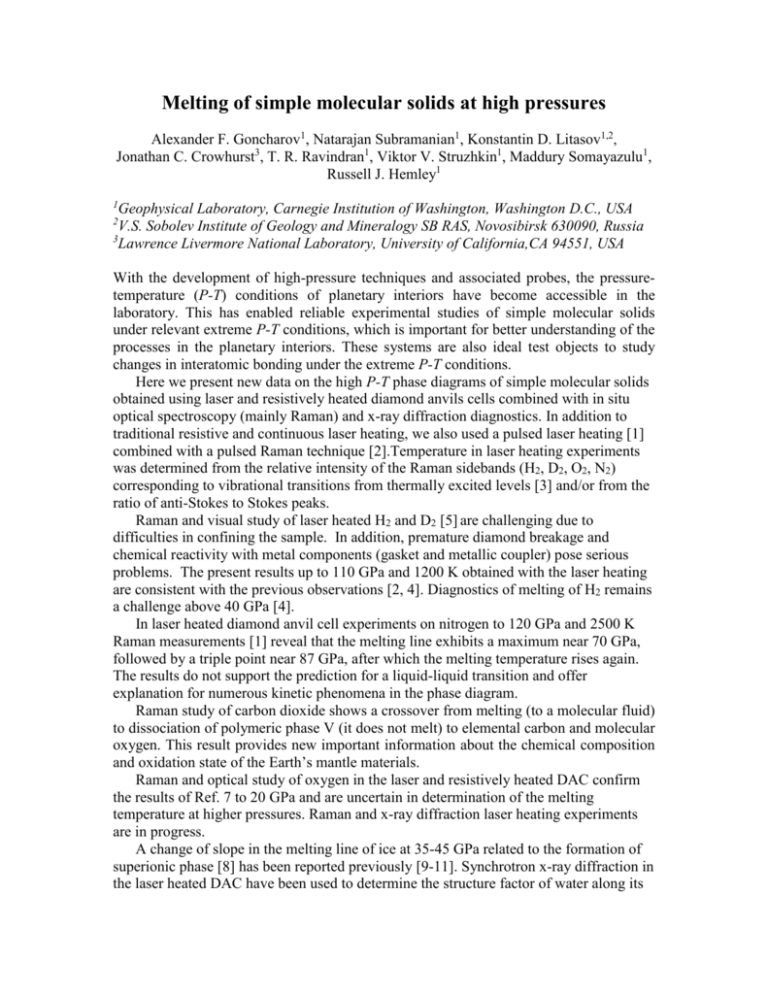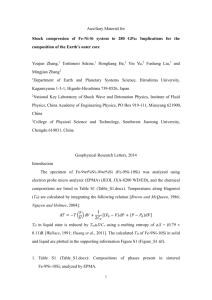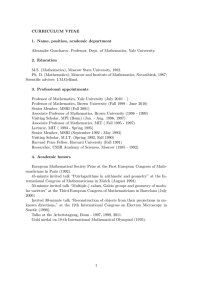Simple molecular solids at high pressures and temperatures
advertisement

Melting of simple molecular solids at high pressures Alexander F. Goncharov1, Natarajan Subramanian1, Konstantin D. Litasov1,2, Jonathan C. Crowhurst3, T. R. Ravindran1, Viktor V. Struzhkin1, Maddury Somayazulu1, Russell J. Hemley1 1 Geophysical Laboratory, Carnegie Institution of Washington, Washington D.C., USA V.S. Sobolev Institute of Geology and Mineralogy SB RAS, Novosibirsk 630090, Russia 3 Lawrence Livermore National Laboratory, University of California,CA 94551, USA 2 With the development of high-pressure techniques and associated probes, the pressuretemperature (P-T) conditions of planetary interiors have become accessible in the laboratory. This has enabled reliable experimental studies of simple molecular solids under relevant extreme P-T conditions, which is important for better understanding of the processes in the planetary interiors. These systems are also ideal test objects to study changes in interatomic bonding under the extreme P-T conditions. Here we present new data on the high P-T phase diagrams of simple molecular solids obtained using laser and resistively heated diamond anvils cells combined with in situ optical spectroscopy (mainly Raman) and x-ray diffraction diagnostics. In addition to traditional resistive and continuous laser heating, we also used a pulsed laser heating [1] combined with a pulsed Raman technique [2].Temperature in laser heating experiments was determined from the relative intensity of the Raman sidebands (H2, D2, O2, N2) corresponding to vibrational transitions from thermally excited levels [3] and/or from the ratio of anti-Stokes to Stokes peaks. Raman and visual study of laser heated H2 and D2 [5] are challenging due to difficulties in confining the sample. In addition, premature diamond breakage and chemical reactivity with metal components (gasket and metallic coupler) pose serious problems. The present results up to 110 GPa and 1200 K obtained with the laser heating are consistent with the previous observations [2, 4]. Diagnostics of melting of H2 remains a challenge above 40 GPa [4]. In laser heated diamond anvil cell experiments on nitrogen to 120 GPa and 2500 K Raman measurements [1] reveal that the melting line exhibits a maximum near 70 GPa, followed by a triple point near 87 GPa, after which the melting temperature rises again. The results do not support the prediction for a liquid-liquid transition and offer explanation for numerous kinetic phenomena in the phase diagram. Raman study of carbon dioxide shows a crossover from melting (to a molecular fluid) to dissociation of polymeric phase V (it does not melt) to elemental carbon and molecular oxygen. This result provides new important information about the chemical composition and oxidation state of the Earth’s mantle materials. Raman and optical study of oxygen in the laser and resistively heated DAC confirm the results of Ref. 7 to 20 GPa and are uncertain in determination of the melting temperature at higher pressures. Raman and x-ray diffraction laser heating experiments are in progress. A change of slope in the melting line of ice at 35-45 GPa related to the formation of superionic phase [8] has been reported previously [9-11]. Synchrotron x-ray diffraction in the laser heated DAC have been used to determine the structure factor of water along its melting line to a static pressure of 57 GPa [12]. Above 4 GPa the O-O structure factor is found to be very close to that of a simple soft sphere liquid, thus permitting us to determine the density of liquid water near the melting line [13]. We acknowledge support by DOE/BES, DOE/NNSA (CDAC), and NSF-DMR. This work was performed under the auspices of the U.S. Department of Energy by Lawrence Livermore National Laboratory in part under Contract No. W-7405-Eng-48 and in part under Contract No. DE-AC52-07NA27344. Literature 1. A. F. Goncharov, J. C. Crowhurst, V. V. Struzhkin, and R. J. Hemley., Phys. Rev. Lett. 101, 095502 (2008). 2. A. F. Goncharov and J. C. Crowhurst, Rev. Sci. Instrum. 76, 063905 (2005). 3. A. F. Goncharov and J. C. Crowhurst, Phys. Rev. Lett. 96, 055504 (2006). 4. E. Gregoryanz A. F. Goncharov, K. Matsuishi, H. K. Mao, and R. J. Hemley. Phys. Rev. Lett. 90 175701 (2003). 5. N. Subramanian, A. F. Goncharov, M. Somayazulu, R. J. Hemley, AIRAPT 2009 Abstract, submitted. 6. K. D. Litasov, A. F. Goncharov, and R. J. Hemley, submitted. 7. G. Weck, P. Loubeyre, J. H. Eggert, M. Mezouar, and M. Hanfland, Phys. Rev. B 76, 054121 (2007). 8. C. Cavazzoni, G. L. Chiarotti, S. Scandolo, E. Tosatti, M. Bernasconi and M. Parrinello, Science, 283, 44 (1999). 9. B. Schwager, L. Chudinovskikh, A. Gavriliuk, and R. Boehler, J. Phys. Condens. Matter 16, S1177 (2004). 10. A. F. Goncharov, N. Goldman, L. E. Fried, J. C. Crowhurst, I. F. W. Kuo, C. J. Mundy and J. M. Zaug, Phys. Rev. Lett., 94, 125508 (2005). 11. Lin, J. F., E. Gregoryanz, V. V. Struzhkin, M. Somayazulu, H. K. Mao, and R. J. Hemley, Geophys. Res. Lett., 32, L11306 (2005). 12. A. F. Goncharov, C. Sanloup, N. Goldman, J. C. Crowhurst, L E. Fried, N. Guignot, M. Mezouar, Y. Meng, MRS Proceedings Fall 2006, Symposium PP, paper #: 0987PP04-03. 13. A. F. Goncharov, C. Sanloup, N. Goldman, J. C. Crowhurst, S. Bastea, W. M. Howard, L. E. Fried, N. Guignot, M. Mezouar, Y. Meng, submitted.









